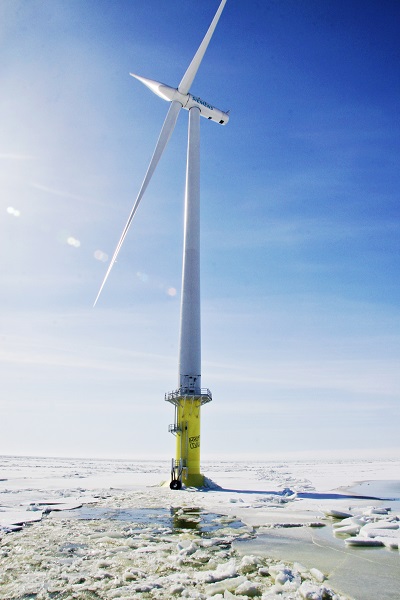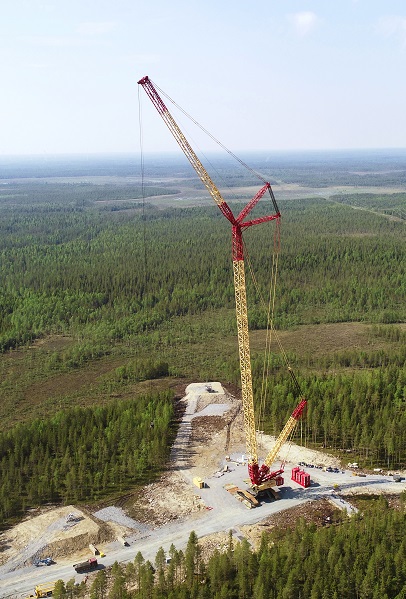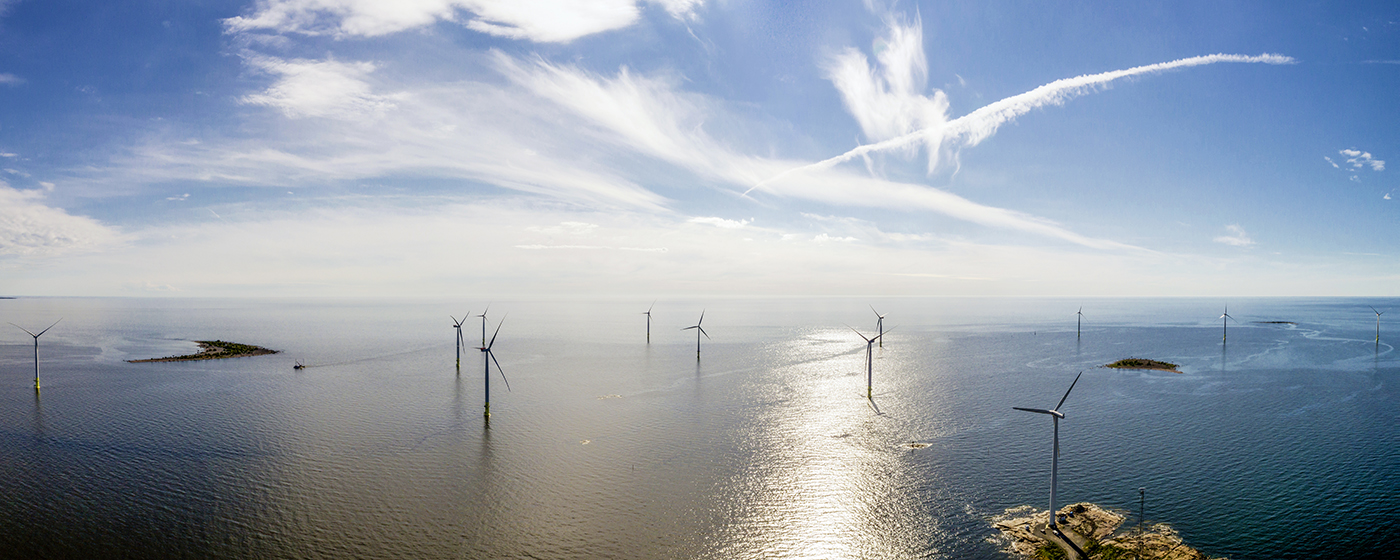At the end of 2018, there were 698 wind turbines in Finland generating a total of 5.8 terawatt hours per year. This covered seven per cent of Finland’s electricity consumption. Non-subsidised wind power capacity of over 520 megawatts is currently under construction. These turbines will be ready for service this year or next.
Fingrid is making preparations for increased wind power generation. Unlike other types of power plant, wind turbines are often located far away from centres of consumption with strong electricity networks.
“We need to reinforce electricity transmission, and this will take time and require comprehensive planning. Fingrid has made substantial investments in getting wind power projects connected to the transmission network, either directly or indirectly. Thankfully, wind turbines tend to be concentrated in certain areas, and this makes the construction of reinforcements easier,” says Antti Kuusela, Expert at Fingrid.
Up to 42 per cent of Finland’s wind turbines are in North Ostrobothnia, while Lapland and Satakunta each have about 12 per cent of the total.
Wind turbines are connected to the grid in a slightly different way from other power plants.
“Wind power generators are connected to the grid with the help of frequency converters. Wind turbines are connected to a substation, where a common regulator controls all of the turbines,” says Kuusela.
Wind power has the wind at its back
According to the Finnish Wind Power Association, as much as 30 per cent of Finland’s electricity consumption could realistically be covered by wind power by 2030, even with the presumption that electricity consumption will increase.
Finland’s wind farms generate domestic, emission-free energy that currently covers seven per cent of our electricity consumption. Finland has good wind conditions, and the country is sparsely populated. This means that there is plenty of potential for adding new wind power.
“In the past, wind farms could only be built with state subsidies, but onshore wind power is now being built independently. The planning and permit processes also used to be very time-consuming because everything was new to developers and the authorities. Now, there are lots of projects underway on market terms, with a substantial pipeline of wind farm projects with spatial plans and building permits, so they will not take long to build. The actual construction phase only takes a year or two,” says Anni Mikkonen, CEO of the Finnish Wind Power Association.
Therefore, we may see rapid growth in the future. Wind power already accounts for nine per cent of Finland’s electricity generation.
“Large companies have made long-term PPA contracts to buy electricity from wind farm companies, and this has served to promote the construction of wind farms on market terms. Wind turbine technology has developed rapidly, while the costs of generation have decreased substantially, so buyers can get electricity from wind farms at below the market price,” Mikkonen says.
According to a 2018 Finnish Energy survey on energy attitudes, as many as four in five respondents wanted more wind power in Finland.
Tahkoluoto: Finland’s first offshore wind farm

In 2010, Suomen Hyötytuuli built Finland’s first offshore wind turbine constructed on offshore foundations in Tahkoluoto, Pori, and in 2017, it built an offshore wind farm around it using ten 4.2-megawatt Siemens wind turbines.
Tahkoluoto is the world’s first offshore wind farm built to withstand icy conditions, and it is expected to generate approximately 155,000 megawatt hours of energy annually. So far, the rate of generation has been in line with this estimate.
“A unique aspect of the Tahkoluoto offshore wind farm is the pedestal solution, which is built to withstand harsh icy conditions. We used our experiences with the first Tahkoluoto wind turbine, as well as experiences with lighthouses and sea marks, to design the wind farm. When we laid the cables, we took care to ensure they were not in very shallow waters. The substation is on land, so it is no different from an onshore wind farm in that respect,” says Miia Suuriniemi, Project Development Manager at Hyötytuuli.
Hyötytuuli is currently gaining experience in servicing and maintaining the offshore wind farm.
“Annual maintenance takes place in the summer, and we visit the turbines as little as possible in the winter. As technology advances, it will become feasible to build offshore wind farms, as the power that can be obtained from a single unit will increase significantly.”
The offshore wind farm is connected to Pori Energia’s network, so the customer cooperation with Fingrid is limited to verifying compliance with the Specifications for the Operational Performance of Power Generating Facilities (known by their Finnish acronym, VJV).
“Fingrid’s VJV process is clear and well communicated. Fingrid also supports its customers, and any ambiguities are always resolved,” Suuriniemi says.

Record-breaking wind turbines erected in Viinamäki
The Viinamäki wind farm, which is currently being built by TuuliWatti in Ii near Oulu, represents state-of-the-art wind turbine technology. Finland’s tallest wind turbines will have a hub height of 175 metres and a rotor diameter of 150 metres.
Erection of the turbines began at the end of May. The Viinamäki wind farm is being built on market terms, and the large-scale energy storage facility will enter service in autumn 2019.
“Taller towers and longer blades generate more power. The wind farm is in the middle of a forest, and the turbines will tower over the trees. Five Vestas V150 turbines will be built in Viinamäki for a combined output of 21 megawatts. The stable wind conditions in Viinamäki and guyed steel towers enable turbines of a record-breaking height,” says Tommi Hietala, TuuliWatti’s Generation Manager.
The turbines will be connected to the electricity network at TuuliWatti’s Simon Halmekangas substation, and power will be transmitted onwards to Fingrid’s Taivalkoski substation. The VJV tests are due to begin no later than November when all of the turbines have been erected.
“The VJV2018 reform made the connection process clearer. The requirements are strict, but they are the same for everyone. Fingrid arranges VJV training events and offers clear documentation on the topic in Finnish and English. It is always clear who should be contacted, and my questions are always answered quickly,” Hietala says.
- Read more: The Nordic region’s largest grid energy storage facility will be built at the Viinamäki wind farm
Customers on an equal footing
Last year, Fingrid reformed its Specifications for the Operational Performance of Power Generating Facilities (known by their Finnish acronym, VJV). Power plants are connected to the transmission system in line with the process set out in the Specifications.
This connection process applies to all power plants, from nuclear power stations to wind turbines. The requirements are the same for everyone, despite the differences between technologies.
When connections are planned, the first step is to verify the connectivity of the power plant and the technical limitations.
“The first phase involves evaluating the power levels and nearby connection points. Once connectivity has been verified, we can move on to the planning phase itself. It is the customer’s job to verify the conformity of the power plant during the project. When the technical conditions for connection have been specified and the plans have been approved, a connection contract can be made,” says Antti Kuusela, Expert at Fingrid.
If the power plant is connected directly to the transmission network, Fingrid guarantees that the transmission network connection will be ready within two years of the connection contract being signed. Connection and commissioning plans are prepared during the construction phase. When the power plant is complete, commissioning inspections and tests are conducted to ensure that the power plant conforms to the requirements.
“Once the connection and final documentation are completed, the grid connection will be ready to go. The power plant will receive a provisional operating permit and, after 18 months, the final operating permit, providing that the commissioning tests are approved. A test report is prepared, and the results are used to model the power plant at Fingrid.”
The requirements are based on Fingrid’s responsibility for the functionality and adequate capacity of the transmission network and Finland’s electricity system as a whole.
My Fingrid helps with information exchange
My Fingrid service portal will make it easier to work together with customers. It will enable Fingrid and customer companies to access all of the information and documentation about the customer.
“My Fingrid enables us to maintain a dialogue with our customers. Information flows better than before, and it is easier to get in touch. The system enables conformance with VJV specifications to be verified, customer and billing details to be monitored, contracts to be read, disturbances to be monitored and new connection projects to be initiated. In the future, information on power plant projects will also be transferred on My Fingrid,” Kuusela promises.






